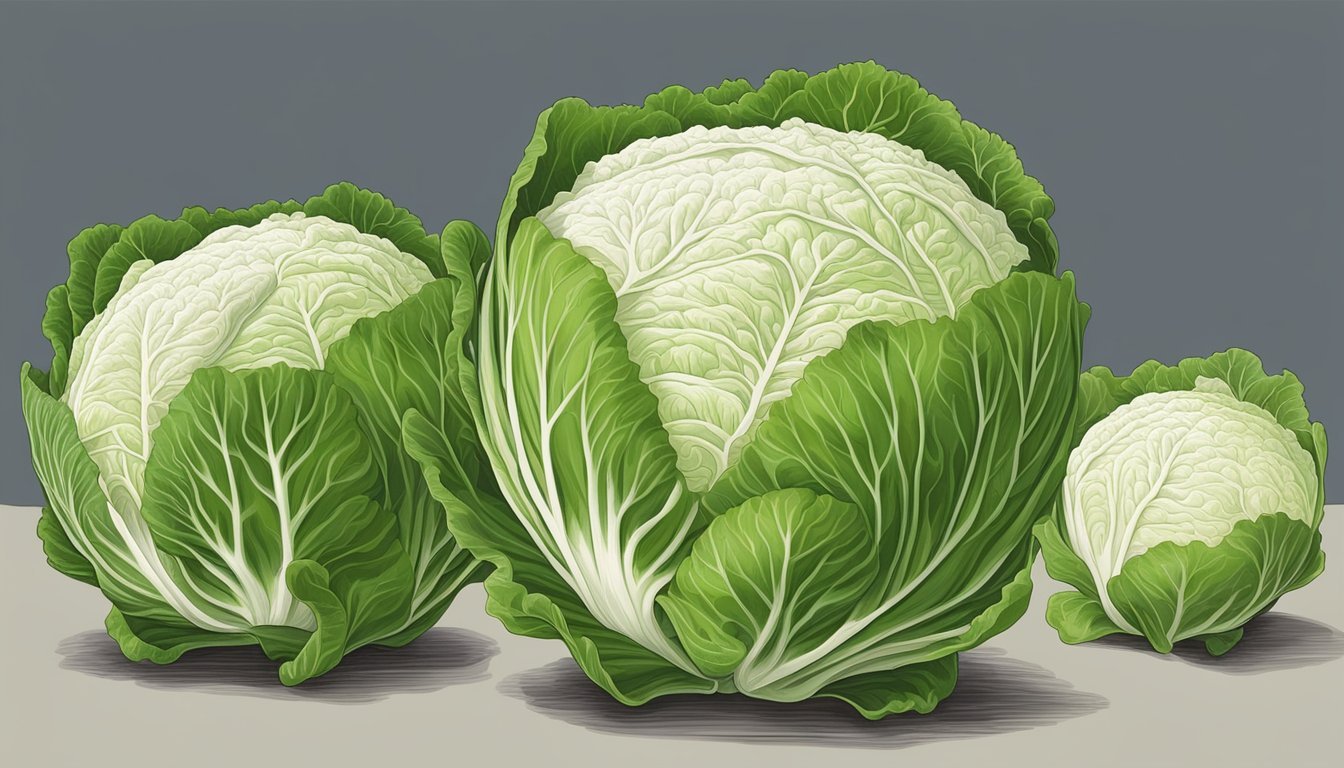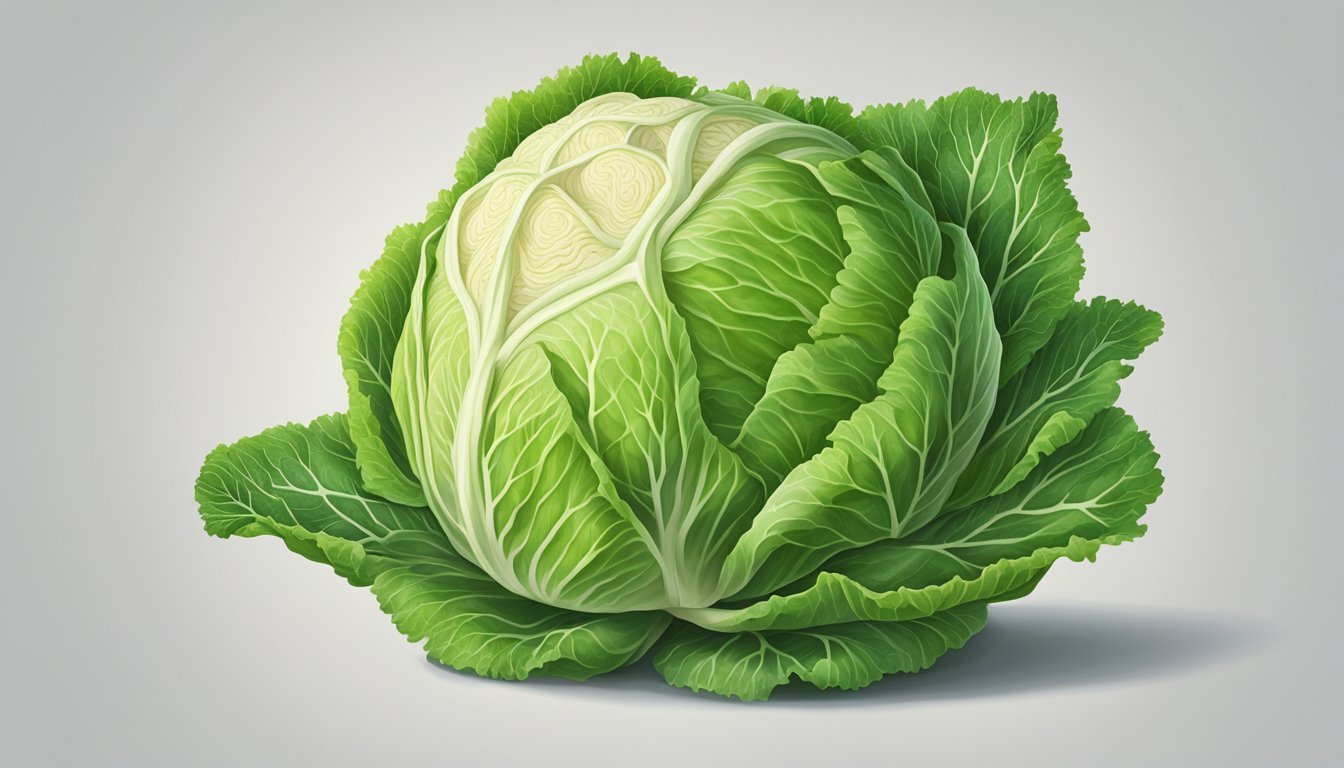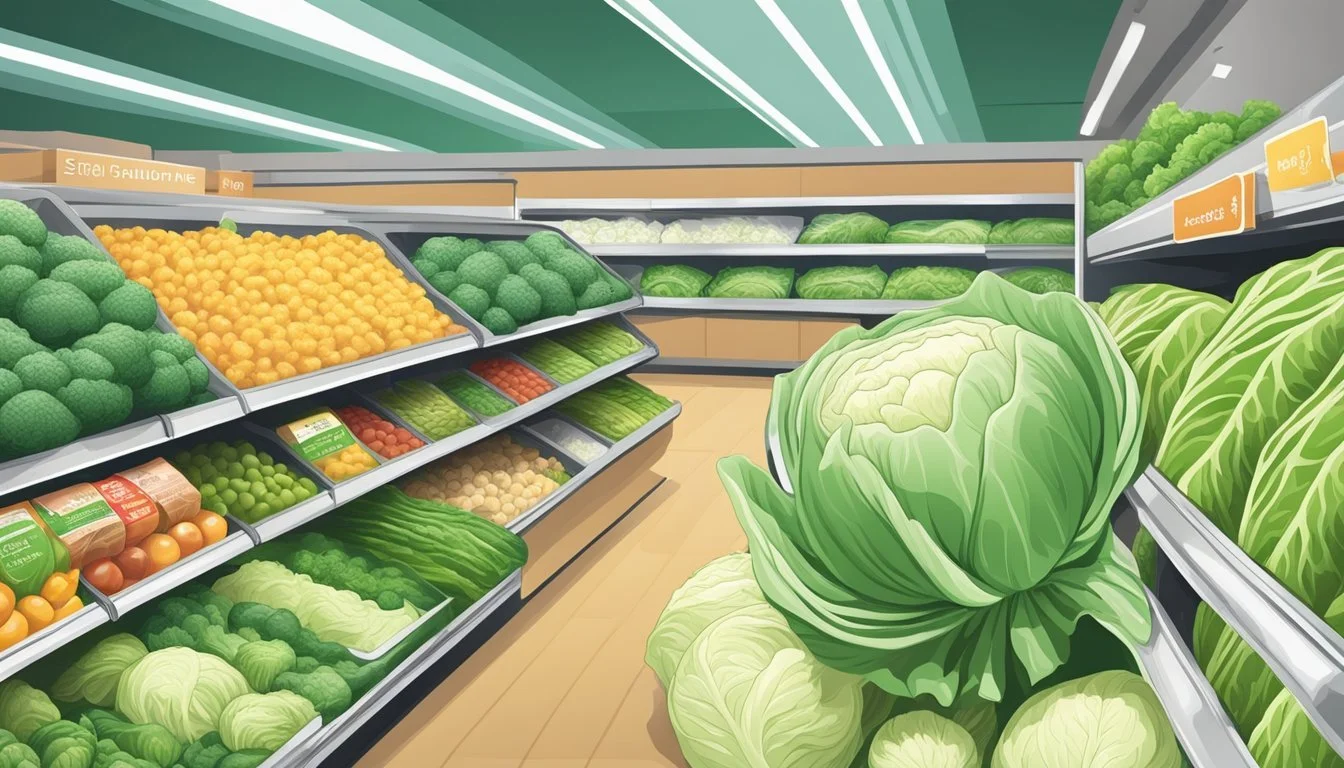How to Substitute Napa Cabbage for Green Cabbage
A Simple Guide
Napa cabbage, with its crisp yet tender leaves, is a staple in many Asian cuisines. It's known for its sweet flavor that turns mellow when cooked, making it an excellent addition to stir-fries, soups, and salads (What wine goes well with salads?). However, it's not always readily available in every grocery store, or sometimes it's simply a matter of preference or dietary needs that prompts the search for an alternative. Knowing how to substitute Napa cabbage for green cabbage can expand culinary possibilities while maintaining the integrity of the dishes.
Green cabbage is a robust alternative with a slightly peppery taste that becomes sweeter upon cooking. Its durability makes it a great candidate for dishes that require longer cooking times, which Napa cabbage might not withstand. While it lacks the frilly texture of Napa cabbage, green cabbage can be sliced thinly to mimic the delicateness of its counterpart. Considering its widespread availability, green cabbage can be a practical and flavorful stand-in for many recipes calling for Napa cabbage.
Understanding Napa Cabbage and Green Cabbage
Napa cabbage, also referred to as Chinese cabbage, is a variety of cabbage with crinkly, pale green leaves and an oblong shape. It is known for its mild flavor and tender texture, which makes it a popular choice in Asian cuisine, particularly in dishes like kimchi and stir-fries. Its leaves are more loosely layered and less tightly packed than other cabbage varieties, offering a different mouthfeel when eaten.
In contrast, green cabbage, often used in Western cooking, has a more pronounced, peppery flavor and a firmer texture. This type of cabbage forms a dense, round head with smooth, tightly packed leaves. It is versatile and holds up well during longer cooking times, making it suitable for recipes like soups, stews, and slaws.
Here's a brief comparison of their characteristics:
Feature Napa Cabbage Green Cabbage Shape Oblong Round Leaf Texture Crinkly and soft Smooth and firm Flavor Mild and slightly sweet Stronger and peppery Cooking Uses Stir-fries, kimchi, salads, hot pot Soups, stews, casseroles, slaws
Both napa and green cabbage are part of the Brassicaceae family, which also includes vegetables like savoy cabbage and red cabbage. Savoy cabbage, with its ruffled leaves, offers a texture closer to napa, while red cabbage brings a vibrant color and a flavor profile akin to green cabbage.
When substituting one for the other, cooks should consider the desired texture and flavor outcome of the dish, as well as the cooking method, to ensure the substitution maintains the integrity of the original recipe.
Nutritional Profile and Health Benefits
Napa cabbage and green cabbage, while both are members of the Brassica family, have distinct nutritional profiles that offer varied health benefits. Here's a brief comparison.
Fiber Content: Both types of cabbage contribute to digestive health, but green cabbage leads with higher fiber content. A 100-gram serving of green cabbage provides approximately 2.5 grams of fiber, which aids in digestion and cardiovascular health.
Vitamins: Vitamins are where these cabbages really differ. Vitamin C, an antioxidant that supports the immune system, is far more abundant in green cabbage. It contains 36.6mg per 100g serving compared to 3.2mg in napa cabbage. However, napa cabbage offers more vitamin A, supplying 263 International Units (IU) per 100g serving, which supports eye health and the immune system. Green cabbage provides only 98 IU of the same amount.
Minerals: Both cabbages contain essential minerals but in varying amounts. Green cabbage may provide a more robust mineral profile with contributions to daily values of manganese and folate for cell growth and maintenance.
In substituting Napa cabbage for green cabbage, one should consider these nutritional differences, particularly if the goal is to boost intake of fiber, vitamin C, or minerals. Although their textures and flavors differ with Napa cabbage being more delicate and water-rich, it can be used effectively in recipes focusing on hydration and lightness, such as salads and slaws.
Culinary Uses of Napa Cabbage
Napa cabbage is a versatile vegetable found in a range of dishes, from fresh salads to hearty soups. Its leaves offer a tender texture and a slightly sweet flavor, making it a popular choice for both raw and cooked preparations.
Raw Preparations
Salads: Napa cabbage serves as an excellent base for salads. Its crisp leaves can be chopped or shredded to mimic coleslaw or combined with other greens for a nutritious mix.
Wraps: The large leaves of Napa cabbage are often used as a wrapper for foods, creating a low-carb alternative to bread or tortillas. They hold fillings well, making them ideal for fresh spring rolls or lettuce wraps.
Cooked Dishes
Kimchi: One of the most well-known uses of Napa cabbage is in kimchi, a traditional fermented Korean side dish. The cabbage is salted, seasoned with various spices, and left to ferment, creating its distinctive flavor.
Soups and Stews: Napa cabbage is a common ingredient in soups and stews. It contributes body and nutrients while easily taking on the flavors of the broth.
Hot Pot: In hot pot dishes, Napa cabbage adds both a subtle sweetness and a pleasant texture as it wilts in the broth.
Dumplings: Often, the cabbage is mixed into fillings for dumplings, adding moisture and a mild flavor.
Noodle Dishes: Napa cabbage can be sliced and quickly cooked in stir-fried noodle dishes.
Stir-fries: The cabbage's ability to retain its structure while softening makes it a favorite for stir-fries, where its layers absorb sauces and seasonings effectively.
Texture and Flavor Considerations
When substituting green cabbage for Napa cabbage, it's essential to consider the differences in texture and flavor to achieve a similar taste and mouthfeel in your dishes.
Taste Profile
Green cabbage tends to have a stronger flavor compared to Napa cabbage's milder taste. While Napa cabbage presents a subtle sweetness, green cabbage can exhibit a slightly more peppery flavor. This might impact the flavor balance of certain recipes, particularly those that call for Napa's characteristic sweetness.
Napa Cabbage: Mild flavor with subtle sweetness
Green Cabbage: Stronger, sometimes peppery flavor
Texture Differences
The texture of Napa cabbage is tender and juicy, whereas green cabbage is usually more crunchy. These characteristics should be taken into account, especially in recipes where the cabbage is not cooked, as green cabbage may require a longer cooking time to achieve a similar tenderness.
Napa Cabbage: Tender and juicy, often used raw
Green Cabbage: Crunchy texture, may need more cooking time
Substituting Napa Cabbage for Green Cabbage
When it comes to cooking, selecting the right substitute can make all the difference in a dish. Napa cabbage, also known as Chinese cabbage, offers a softer texture and a milder, sweeter taste than its counterpart, green cabbage. This difference should be taken into consideration when using Napa cabbage as a substitute in various recipes that call for green cabbage.
Soups and Stir-Fries
For soups and stir-fries, Napa cabbage seamlessly integrates due to its tender leaves, which wilt nicely and complement the dish's texture. One should cut the Napa cabbage into thin strips, much like one would do with green cabbage, to maintain a consistent bite throughout the dish.
Soups: Add the Napa cabbage in the last few minutes of cooking to preserve its texture.
Stir-fries: Stir-fry Napa cabbage on medium-high heat for a short time to keep its crunch.
Salads
Napa cabbage also works well as a green cabbage substitute in salads. Its softer texture and pleated leaves add a delightful dimension to the salad's structure.
Salad Preparation: Chop the Napa cabbage into bite-sized pieces. Dress the salad just before serving to avoid sogginess.
Considerations
When using Napa cabbage, keep in mind that it has a higher water content than green cabbage. This quality makes it less suitable for dishes such as coleslaw, where green cabbage's sturdier nature is preferable. However, for those who enjoy a tender and delicate crunch, Napa cabbage is a viable and delicious substitute.
Here's a simple table to clarify the substitution for different dishes:
Dish Type Substitution Note Salads Use raw, chopped Napa cabbage Stir-fries Add last to retain slight crunch Soups Introduce towards the end of cooking
Remember, the quantity of Napa cabbage used may vary based on personal preference and the specific requirements of your recipe.
Alternative Cabbage Variants and Substitutes
When substituting Napa cabbage in recipes, one can consider several leafy greens that mirror its texture and flavor profile, albeit with slight variations.
Bok Choy: A close relative to Napa cabbage, Bok choy offers a sweet, yet mildly peppery taste. It's commonly used in Asian cuisine and provides a crisp texture, making it an excellent substitute in stir-fries and salads.
Leafy Options:
Kale: Available in varieties such as curly kale and baby kale, this leafy green is robust and may possess a bitter taste if used raw. Kale can withstand cooking and is suitable for dishes where Napa cabbage is cooked.
Swiss Chard: Swiss chard comes with green, leafy tops and colorful stems. Its slightly sweet flavor with earthy undertones makes it a versatile choice for a variety of dishes, including sautés and soups.
Romaine Lettuce: Offering a delicate crunch, romaine can be used in raw applications like lettuce wraps, where its sturdy leaves hold fillings well, albeit with a lighter texture.
Endives: These provide a bitter taste, which can be mellowed through cooking. Endives are suitable for braised or grilled dishes.
Less Common Substitutes:
Kohlrabi: Crunchy and slightly sweet, kohlrabi can substitute Napa cabbage in both raw and cooked forms, though its bulbous shape requires it to be sliced thinly.
The goal is to find a substitute that maintains the balance in a dish, considering whether the Napa cabbage was meant to add a delicate texture, a mellow sweetness, or simply to contribute volume as a leafy green. Each substitute offers its unique properties, but all can be incorporated successfully into a variety of recipes.
Cooking Methods and Preparation Tips
When substituting green cabbage for Napa cabbage, one must consider the textural differences and adapt the cooking method to achieve the desired outcome. Green cabbage is generally firmer and more peppery, requiring slight adjustments for steaming, boiling, roasting, or grilling.
Steaming and Boiling
Steaming or boiling green cabbage is an excellent way to soften its robust structure, making it more similar to the tender consistency of Napa cabbage. To steam green cabbage, it should be sliced into thin wedges and placed in a steamer basket over simmering water for about 5-7 minutes, until it reaches the desired tenderness. For boiling, the cabbage should be cut into thicker chunks compared to Napa, and immersed in a pot of boiling water for approximately 3-5 minutes. One should monitor the texture to prevent overcooking, which can lead to a mushy texture, unlike the crispness associated with Napa cabbage.
Roasting and Grilling
Roasting and grilling bring out the naturally sweet notes of green cabbage, creating a caramelized exterior that matches the subtle sweetness when Napa cabbage is cooked. Cabbage should be sliced into hearty steaks or chunks, and brushed lightly with oil to help in the caramelization process. For roasting, green cabbage requires a higher heat — about 400°F (204°C) for 20-25 minutes — compared to Napa. When grilling, the firm leaves hold up well against the direct heat, and each side should be grilled for about 5 minutes or until char marks form. This method can replicate the slightly waxy texture of Napa, though it is essential to maintain a careful watch, as green cabbage can go from perfectly grilled to overdone rather quickly.
Pairing Ingredients with Napa Cabbage
Napa cabbage, an East Asian vegetable, harmonizes well with a variety of ingredients commonly found in Asian cuisine. Its mild and slightly sweet taste makes it ideal for both fresh and cooked applications.
In Salads: Napa cabbage forms the perfect base for salads. One can incorporate ingredients like:
Carrots: Shredded for a crisp texture and a pop of color.
Cucumbers: Thinly sliced for a refreshing crunch.
Bell peppers: Julienned to introduce a sweet or tangy accent.
For Stir-fries and Wraps: Its soft yet sturdy leaves are excellent for:
Garlic and Ginger: These aromatics complement the gentle sweetness of Napa cabbage when stir-fried together.
Tofu or Tempeh: Provides a protein-rich addition that pairs well in wraps or as a stir-fry component.
In Coleslaw: Napa cabbage's texture is less crunchy than green cabbage but it absorbs dressings beautifully, making it a suitable alternative in slaw. Combine with ingredients such as:
Mayonnaise: For a creamy coleslaw dressing.
Vinegar: Adding a tangy component to the slaw dressing.
When Used Raw: Napa cabbage adds a subtle crispness to wraps and salads without overpowering other flavors.
Cooked Dishes: Napa cabbage lends itself well to a variety of cooked dishes, transforming in texture and flavor upon cooking.
Cooking Method Partner Ingredients Steaming Light sauces, delicate spices Braising Robust sauces, bolder seasoning blends Sautéing Aromatic vegetables, sesame oil, garlic
Taiwanese cabbage may also be used interchangeably due to its similar taste profile. When paired thoughtfully, Napa cabbage complements a myriad of ingredients, making it a versatile addition to East Asian-inspired dishes.
Navigating the Produce Aisle
When looking for a substitute for Napa cabbage in the produce aisle, one should consider a few different options. Green cabbage is the most common and can be found easily in most grocery stores. It is a reliable alternative due to its similar texture, though it is typically firmer and has a more pronounced flavor.
In addition to regular green cabbage, Savoy cabbage, with its crinkled leaves, is a suitable stand-in for Napa cabbage, offering a milder taste and tender texture. Red cabbage could also suffice, provided the color contrast is not an issue for the dish in question.
For those interested in a closer match, pointed cabbage, which is sometimes labeled as hispi or hearted cabbage, provides a good balance of texture and flavor, resembling that of Napa cabbage.
Here is a quick rundown of possible substitutes:
Substitute Texture Flavor Notes Green Cabbage Firm and Crunchy Peppery, Pronounced Savoy Cabbage Tender Crinkles Mild, Slightly Sweet Red Cabbage Crunchy Earthy, Peppery Pointed Cabbage Soft, Tender Sweet, Subtle
If one does not find these common cabbages suitable, broccoli or choy sum might also serve as possible alternatives, especially in cooked dishes. Broccoli offers a unique texture and flavor, while choy sum maintains a mild taste with a leafy texture, particularly when one desires less of the cabbage flavor.
Shopping tip: Always look for firm heads with crisp leaves and no signs of wilting to ensure the best quality, regardless of the type of cabbage selected.
Creative Recipes Featuring Napa Cabbage
Napa Cabbage Stir-Fry: One can capitalize on the tender leaves of Napa cabbage by incorporating them into a vibrant stir-fry. Cook them with a selection of colorful vegetables such as bell peppers and carrots, and add a protein of choice like tofu or chicken. Season with soy sauce, garlic, and ginger for a simple yet satisfying meal.
Kimchi: As a traditional Korean staple, Napa cabbage serves as the foundation for the beloved kimchi. Its leaves are salted and fermented with a mixture of chili flakes, garlic, ginger, and fish sauce. The result is a spicy, tangy dish that can complement any meal or be enjoyed on its own.
Napa Cabbage Salad: A refreshing salad can be put together using raw Napa cabbage as a crunchy base. Mix in other salad favorites like cucumber, carrots, and scallions. Dress it with a light vinaigrette or go for bold flavors with a peanut dressing.
Dumplings with Napa Cabbage: They are made even tastier when Napa cabbage is incorporated into the filling. It provides moisture and texture, pairing especially well with minced pork or shrimp. Wrap this filling in dumpling skins and steam or fry as desired.
Napa Cabbage in Noodle Dishes: When added to noodle dishes, Napa cabbage brings a sweet depth of flavor that complements both the noodles and the sauce. It can be used in soups or tossed with stir-fried noodles and a variety of sauces ranging from soy-based to spicy.
By incorporating Napa cabbage into these dishes, cooks can enjoy its versatility and delicate texture, adding a nutritional boost and enhanced flavors to familiar recipes.









